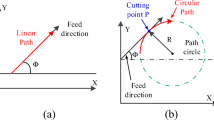Abstract
Trochoidal milling is an alternative tool path strategy which has been shown to increase productivity, improve tooling life, and reduce resultant cutting forces. While the advantages of trochoidal milling over conventional slot or shoulder milling were previously reported, the complexity of trochoid tool path makes developing an analytical force model highly complicated. In this work, a numerical algorithm to construct the uncut chip thickness model in trochoidal milling is introduced, which is based on the geometrical relation of self-intersection and cross-intersection points of the tool path curve. In addition, an extensive series of experiments is carried out in slot and trochoidal-milling operations in order to investigate the dependency of cutting pressure coefficients on tool path parameters and to develop a model to relate the two. Furthermore, the performance of the developed model for uncut chip thickness and the cutting pressure coefficients are evaluated in predicting cutting forces; it is shown that the model predicts the maximum cutting force in the feed direction and between all the testing sets with 8% total average error, while 17% total average error is observed in predicting maximum cutting force in the lateral direction. This demonstrates the potential of the proposed approach in offline simulation of the cutting forces which is a critical step in selecting proper tooling and process parameters to increase productivity of the cut.
Similar content being viewed by others
References
Djurdjanovic D, Mears L, Akhavan Niaki F, Ul Haq A, Li L (2017) State of the art review on process, system, and operations control in modern manufacturing. J Manuf Sci Eng. https://doi.org/10.1115/1.4038074
Toh CK (2003) Tool life and tool wear during high-speed rough milling using alternative cutter path strategies. Proc Inst Mech Eng Part B J Eng Manuf 217:1295–1304
Landers RG, Ulsoy AG (2000) Model-based machining force control. J Dyn Syst Meas Control 122:521–527
Denkena B, Flöter F (2012) Adaptive cutting force control on a milling machine with hybrid axis configuration. Procedia CIRP 4:109–114
Lee A-C, Lin M-T, Pan Y-R, Lin W-Y (2011) The feedrate scheduling of NURBS interpolator for CNC machine tools. Comput Des 43:612–628
Akhavan Niaki F, Michel M, Mears L (2016) State of health monitoring in machining: extended Kalman filter for tool wear assessment in turning of IN718 hard-to-machine alloy. SI NAMRC. J Manuf Process 24(Part 2):361–369
Pleta A, Ulutan D, Mears L (2014) Investigation of trochoidal milling in nickel-based superalloy inconel 738 and comparison with end milling. In: ASME 2014 International Manufacturing Science and Engineering Conference collocated with the JSME 2014 International Conference on Materials and Processing and the 42nd North American Manufacturing Research Conference. American Society of Mechanical Engineers, p V002T02A058-V002T02A058
Pleta A, Ulutan D, Mears L (2015) An investigation of alternative path planning strategies for machining of nickel-based superalloys. Procedia Manuf 1:556–566. https://doi.org/10.1016/J.PROMFG.2015.09.032
Uhlmann E, Fürstmann P, Rosenau B, et al (2013) The potential of reducing the energy consumption for machining TiAl6V4 by using innovative metal cutting processes. In: 11th Global Conference on Sustainable Manufacturing. Berlin, pp 593–598
Rauch M, Duc E, Hascoet J-Y (2009) Improving trochoidal tool paths generation and implementation using process constraints modelling. Int J Mach Tools Manuf 49:375–383. https://doi.org/10.1016/J.IJMACHTOOLS.2008.12.006
Shixiong W, Wei M, Bin L, Chengyong W (2016) Trochoidal machining for the high-speed milling of pockets. J Mater Process Technol 233:29–43. https://doi.org/10.1016/J.JMATPROTEC.2016.01.033
Szalóki I, Csuka S, Sipos S (2014) New test results in cycloid-forming trochoidal milling - Google Search. Acta Polytech Hung 11:1–14
Salehi M, Blum M, Fath B, Akyol T, Haas R, Ovtcharova J (2016) Epicycloidal versus trochoidal milling-comparison of cutting force, tool tip vibration, and machining cycle time. Procedia CIRP 46:230–233. https://doi.org/10.1016/J.PROCIR.2016.04.001
Otkur M, Lazoglu I (2007) Trochoidal milling. Int J Mach Tools Manuf 47:1324–1332
Kardes N, Altintas Y (2007) Mechanics and dynamics of the circular milling process. J Manuf Sci Eng 129:21. https://doi.org/10.1115/1.2345391
Lawrence JD (1972) A catalog of special plane curves. Dover Publications, Mineola
Tlusty J (2000) Manufacturing processes and equipment. Prentice-Hall
Rubeo MA, Schmitz TL (2016) Milling force modeling: a comparison of two approaches. Procedia Manuf 5:90–105
Acknowledgments
The authors would like to thank Mr. Douglas M. Schwarz of the University of Rochester for providing his source code for finding intersection points.
Author information
Authors and Affiliations
Corresponding author
Rights and permissions
About this article
Cite this article
Akhavan Niaki, F., Pleta, A. & Mears, L. Trochoidal milling: investigation of a new approach on uncut chip thickness modeling and cutting force simulation in an alternative path planning strategy. Int J Adv Manuf Technol 97, 641–656 (2018). https://doi.org/10.1007/s00170-018-1967-0
Received:
Accepted:
Published:
Issue Date:
DOI: https://doi.org/10.1007/s00170-018-1967-0



